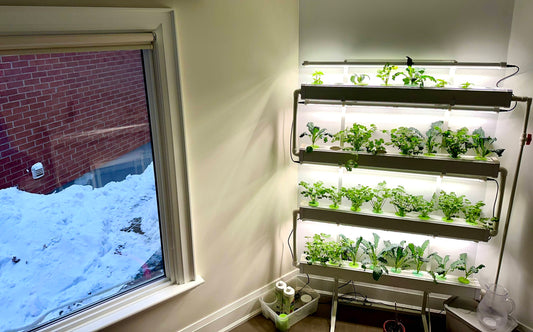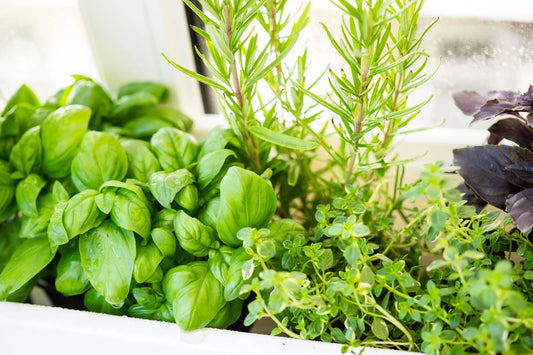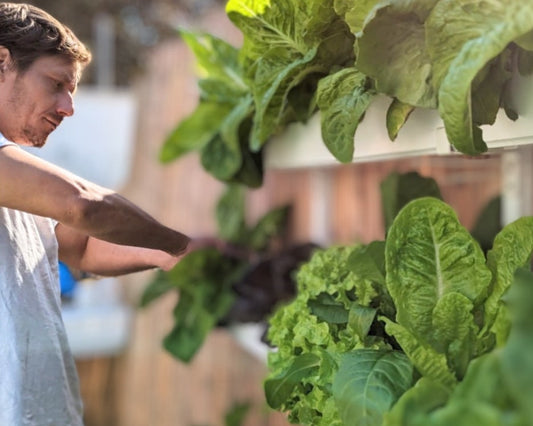Are you looking to enhance the growth of your hydroponic garden?
Imagine harvesting lush, vibrant plants all year round, regardless of the weather outside.
One of the most crucial factors in successful indoor cultivation is finding the right balance between natural and artificial illumination.
Let's explore how to create the ideal lighting environment for your hydroponic plants to thrive!

Natural vs. Artificial Light: Finding the Right Mix
Plants rely on light for photosynthesis, but not all light sources are equally beneficial.
Different hydroponic plants have varying light preferences, and providing the right type and amount of light is essential for optimal growth.
For instance, leafy greens like lettuce and spinach thrive under cooler, blue-spectrum lights and require about 12-16 hours of light daily.
Understanding these distinctions can distinguish between a mediocre harvest and a bountiful one.
1. Create an Ideal Lighting Environment
Begin by assessing the natural light in your growing area:
- South-facing windows provide the most sunlight.
- East or west-facing windows offer moderate light levels.
- North-facing windows typically provide minimal direct sunlight.
Use a light meter to measure the actual light levels in your space throughout the day for more accurate planning.
For example, hydroponic tomatoes need around 14-18 hours of light per day with an intensity of 20,000-30,000 lux.
If natural light is insufficient, which is often the case indoors, use high-intensity LED grow lights.

2. Understand Plant-Specific Light Requirements
Different plants have varying light needs. For instance, low-light plants such as basil or cilantro need only 4-6 hours of direct light daily.
- Meanwhile, medium-light plants such as leafy greens require daily 6-8 hours of direct light.
- For high-light plants (fruiting vegetables), you must provide 8-12 hours of direct light daily.
For growers with short winter days and often overcast, this means relying more heavily on artificial lighting during the colder months to ensure your plants receive adequate light.
3. Select Appropriate Artificial Lighting
Choose artificial lights based on your plant's needs and your space:
- LED Grow Lights: Energy-efficient and customizable
- Fluorescent Lights: Suitable for seedlings and low-light plants
- High-Intensity Discharge (HID) Lights: Powerful but energy-intensive
Consider factors such as energy efficiency, heat output, and spectrum when selecting!

4. Optimize Light Placement
In addition to choosing the correct type of artificial light, proper positioning of them is crucial:
- Maintain appropriate distances: 6-12 inches for LEDs and 12-18 inches for fluorescents.
- Ensure even light distribution across all plants
- Use adjustable hangers to modify light height as plants grow
Remember, proper light placement can significantly impact your plants' health and yield, so carefully set up your lighting system!
Plus, the dark period is crucial for plant metabolism and overall health. Many growers find using a timer for their lighting system helpful in maintaining a consistent schedule.

Integrating Natural and Artificial Light
Now, let's explore how to combine natural and artificial light sources effectively:
- Use artificial lights to complement natural light, filling in gaps when sunlight is insufficient.
- Gradually increase light intensity in the morning and decrease in the evening to simulate natural light cycles.
- Position high-light plants near windows and use artificial lights for plants in less illuminated areas.

Troubleshooting Common Lighting Issues
Even with careful planning, you may encounter lighting challenges with hydroponics.
Watch out for these symptoms:
- Elongated stems are an indication of insufficient light. Move lights closer or increase intensity.
- Scorched leaves suggest excessive light. Increase the distance between plants and lights.
- Slow growth may signify inadequate illumination. Consider increasing light levels for these plants.
Remember, achieving the perfect balance is an ongoing process. Don't hesitate to make adjustments based on your plants' responses!
Illuminate the Path to Hydroponic Success
By mastering the art of balancing natural and artificial light, you're well on your way to creating an optimal environment for your hydroponic garden.
Remember that each plant species has unique needs, so be prepared to fine-tune your lighting strategy as you gain experience!
Are you ready to illuminate your hydroponic systems? Dive into our hydroponic kits or explore grow lights to start growing your own hydroponic plants year-round.
Why Nature Tech?
- Our hydroponic systems save up to 90% more water than traditional growing methods.
- All hydroponic growing systems are designed for modern life with maximum yield, minimum effort, and endless beauty & joy.
- Our systems are made of food-safe plastics that don't contaminate the water with unhealthy compounds.
- Our compact and adaptable set-up can be used in large indoor spaces or a small balcony – wherever you choose, your plants will flourish.
- Our home-growing systems are easy to use - even for beginner gardeners!
- With our systems, your plants grow up to 3x faster than in soil, so you’ll save more time!
- We’re here to offer help every step of the way. If you need advice or have any doubts, please contact us!




